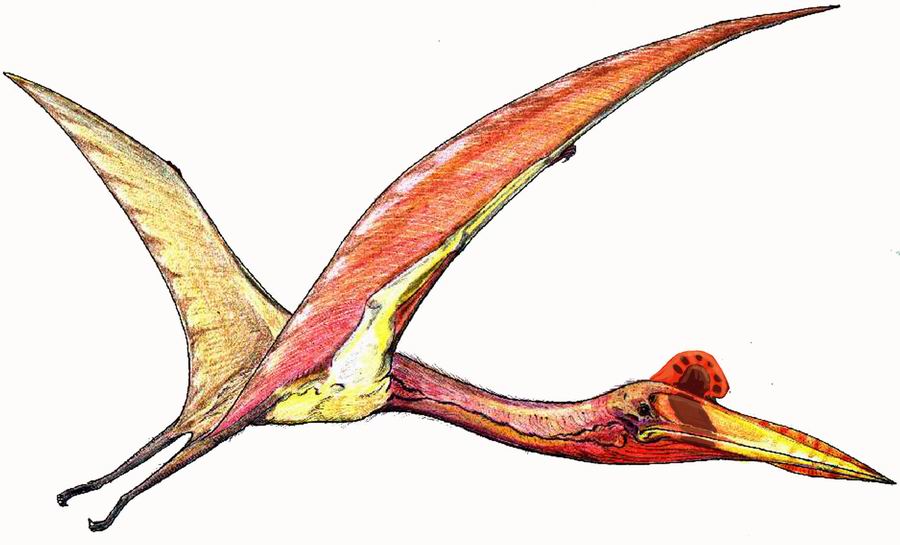- Quetzalcoatlus
Taxobox
name = "Quetzalcoatlus"

image_width = 250px
image_caption = Life restoration of "Quetzalcoatlus".
fossil_range =Late Cretaceous
regnum =Animal ia
phylum = Chordata
classis = Sauropsida
ordo =Pterosauria
subordo =Pterodactyloidea
familia =Azhdarchidae
genus = "Quetzalcoatlus"
genus_authority = Lawson, 1975
subdivision_ranks = Species
subdivision = "Q. northropi" Lawson, 1975 (type) "Q." sp. "vide" Kellner & Langston, 1996"Quetzalcoatlus" (named for the
Aztec feathered serpent godQuetzalcoatl ) was a pterodactyloidpterosaur known from theLate Cretaceous of North America (Campanian –Maastrichtian stages, 84–65 ma), and one of the largest known flying animals of all time. It was a member of theAzhdarchidae , a family of advanced toothless pterosaurs with unusually long, stiffened necks.Discovery and species
The first "Quetzalcoatlus" fossils were discovered in
Texas (from theJavelina Formation atBig Bend National Park ) in 1971 byDouglas A. Lawson . The specimen (numbered TMM 41450-41453) consisted of a partial wing (made up of the forearms and elongated 4th finger in pterosaurs), from an individual later estimated at over to 10 m (33 ft) inwingspan .Witton, M.P., and Naish, D. (2008). "A Reappraisal of Azhdarchid Pterosaur Functional Morphology and Paleoecology." "PLoS ONE", 3(5): e2271. doi:10.1371/journal.pone.0002271 [http://www.plosone.org/article/info%3Adoi%2F10.1371%2Fjournal.pone.0002271 Full text online] ] Lawson assigned the specimen to a new genus and species, "Quetzalcoatlus northropi". Lawson, D. A. (1975). "Pterosaur from the Latest Cretaceous of West Texas. Discovery of the Largest Flying Creature." "Science", 187: 947-948.] A second, yet-unnamed species from Texas was reported by Kellner and Langston in 1996.Kellner, A.W.A., and Langston, W. (1996). "Cranial remains of "Quetzalcoatlus" (Pterosauria, Azhdarchidae) from Late Cretaceous sediments of Big Bend National Park, Texas." "Journal of Vertebrate Paleontology", 16: 222–231.] The specimen (known provisionally as "Q." sp.) is more complete than "Q. northropi", and includes a partial skull, though it is much smaller, with an estimated wingspan of 5.5 meters (18 ft).Buffetaut, E., Grigorescu, D., and Csiki, Z. (2002). "A new giant pterosaur with a robust skull from the latest Cretaceous of Romania." "Naturwissenschaften", 89: 180–184.]An azhdarchid neck vertebrae, discovered in 2002 from the
Hell Creek Formation , may also belong to "Quetzalcoatlus". The specimen (BMR P2002.2) was recovered accidentally when it was included in a field jacket prepared to transport part of atyrannosaur specimen. Despite this association with the remains of a large carnivorousdinosaur , it shows no evidence that it was fed on by the dinosaur. The bone came from an individual pterosaur estimated to have had a wingspan of 5 - 5.5m (16.5 - 18 ft).Henderson, M.D. and Peterson, J.E. "An azhdarchid pterosaur cervical vertebra from the Hell Creek Formation (Maastrichtian) of southeastern Montana." "Journal of Vertebrate Paleontology", 26(1): 192–195.]Paleobiology
There are a number of different ideas about the lifestyle of "Quetzalcoatlus". With its long neck
vertebrae and long toothless jaws it might have fed on fish like aheron , or perhaps it scavenged like theMarabou Stork . Others maintain that it fed like modern-dayskimmer s. Presumably "Quetzalcoatlus" could take off under its own power, but once aloft it may have spent much of its time soaring. On the ground, "Quetzalcoatlus" probably walked on all fours. Recent studies suggest that it may have hunted on the ground like a modernstork , using flight as a method of long-range transport.Witton, M.P., and Naish, D. (2008). "A Reappraisal of Azhdarchid Pterosaur Functional Morphology and Paleoecology." "PLoS ONE", 3(5): e2271. doi:10.1371/journal.pone.0002271 [http://www.plosone.org/article/info%3Adoi%2F10.1371%2Fjournal.pone.0002271 Full text online] ] There have been suggestions that the largest "Quetzalcoatlus" specimens represent an upper biological limit for flight.Fact|date=September 2007 The largest remains indicate an individual with a wingspan as large as 12 m (40 ft), though more recent estimates based on greater knowledge of azhdarchid proportions place its wingspan at 10-11 meters (33-36 ft). However, similar claims to an upper size limit for flight accompanied the discovery of large (up to 9 m (30 ft)) "Pteranodon ", and azhdarchids larger than "Quetzalcoatlus" with wingspans 12 meters or more (such as "Hatzegopteryx ") have been discovered.Buffetaut, E., Grigorescu, D., and Csiki, Z. (2002). "A new giant pterosaur with a robust skull from the latest Cretaceous of Romania." "Naturwissenschaften", 89(4): 180-184. [http://www.springerlink.com/content/w55xf7hvvmwp6t5c/ Abstract] ]During the
Cretaceous period, Texas' climate was similar to modern tropical coastalwetland s and lagoons, extending along theCretaceous Seaway that filled the center of North America. Bones of related animals are also known fromDinosaur Provincial Park ,Alberta ,Canada .Along with the
dinosaur s, "Quetzalcoatlus" became extinct at the end of the Cretaceous period.In popular culture
There is a fictional species of "Quetzalcoatlus" known as
Skybax in the "Dinotopia " series. It is also featured in thenature documentary "Walking with Dinosaurs " episode "Death of a Dynasty", 3rd episode of "Dinosaur Planet", and "When Dinosaurs Roamed America ", episode 5 (LateCretaceous ).References
External links
* [http://www.pterosaur.co.uk/species/UCP/Quetzalcoatlus-001.pdf "Quetzalcoatlus northropi" - A pterosaur from the Upper Cretaceous] (pdf)
Wikimedia Foundation. 2010.
